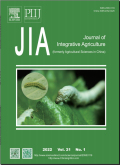首页|期刊导航|农业科学学报(英文)|Sugarcane/soybean intercropping with reduced nitrogen addition enhances residue-derived labile soil organic carbon and microbial network complexity in the soil during straw decomposition
农业科学学报(英文)2024,Vol.23Issue(12):4216-4236,21.DOI:10.1016/j.jia.2024.02.020
Sugarcane/soybean intercropping with reduced nitrogen addition enhances residue-derived labile soil organic carbon and microbial network complexity in the soil during straw decomposition
Sugarcane/soybean intercropping with reduced nitrogen addition enhances residue-derived labile soil organic carbon and microbial network complexity in the soil during straw decomposition
摘要
关键词
sugarcane/soybean intercropping/13C-labeled straw/labile SOC fractions/microbial networksKey words
sugarcane/soybean intercropping/13C-labeled straw/labile SOC fractions/microbial networks引用本文复制引用
Tantan Zhang,Yali Liu,Shiqiang Ge,Peng Peng,Hu Tang,Jianwu Wang..Sugarcane/soybean intercropping with reduced nitrogen addition enhances residue-derived labile soil organic carbon and microbial network complexity in the soil during straw decomposition[J].农业科学学报(英文),2024,23(12):4216-4236,21.基金项目
This research was supported by the China National Key R&D Program during the 14th Five-year Plan Period(2022YFD1901603).The authors would like to thank Elsevier for its linguistic assistance during the preparation of this manuscript. (2022YFD1901603)

